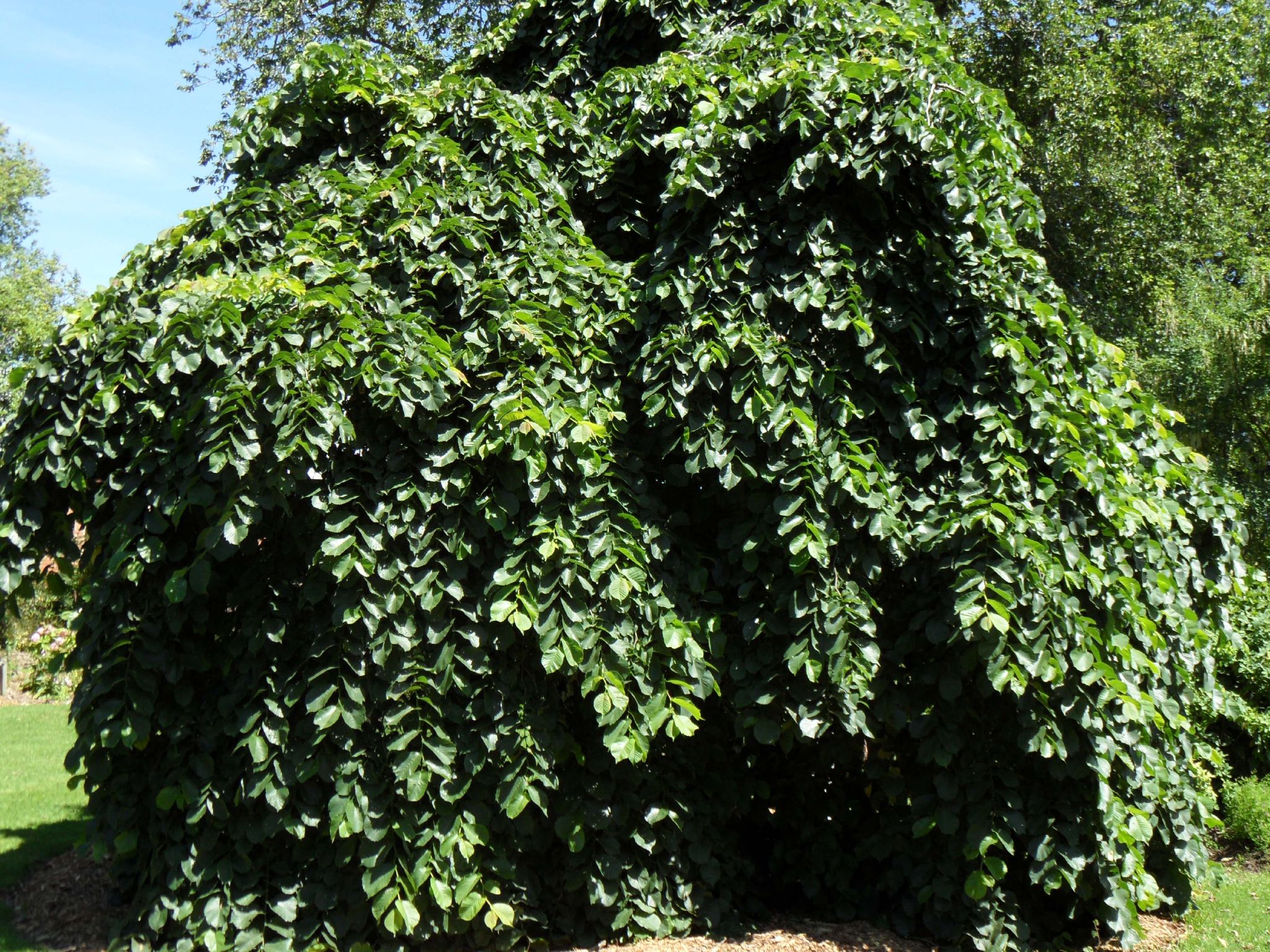
A non-suckering, wide-spreading, broad crowned tree to 30 m or so tall. Branches in higher part of tree with less fissuring than below and on older trees drooping at the ends to form an enclosed inner space. Branchlets stout, downy. Winter buds hairy. Leaves mostly 8-16 cm long, oval to obovate, occasionally with small additional lobing in the top half, margins with double serrations and a long pointed tip, rough and dull above, soft-hairy beneath; basal leaf lobe overlapping both the leaf stalk and branchlet; vein pairs 12-18. Leaf stalks mostly less than 5 mm long. Fruit 15-20 mm long with the seed in the centre. [U. campestris L. in part]
UK to Siberia
Widely planted for its attractive rounded habit and lack of suckers. Now used as a rootstock for other elms as well as the grafted, weeping elms. First recorded Australian introduction 1860.
Shoots and short leaf stalks downy; leaves large, long-pointed with very rough upper surface; basal lobe extending well over branchlet as well as leaf stalk.
ACT: Griffith (Grant Crt). NSW: Orange (Cook Park). VIC: Ballarat (Lydiard St); Melbourne (Kings Domain, Birdwood Ave. opposite Nursery entrance to Royal Botanic Gardens Victoria (Melbourne Gardens), several-one large); South Yarra (Fawkner Park); Box Hill (Central Plantation, Whitehorse Rd). TAS: Launceston (Brickfields Reserve, City Park).
Source: (1997). Ulmus. In: . Horticultural Flora of South-eastern Australia. Volume 2. Flowering plants. Dicotyledons. Part 1. The identification of garden and cultivated plants. University of New South Wales Press.

Camperdown Elm (Weeping Elm). A weeping cultivar with a small, arbor-like habit and a rounded crown. Branches contorted just above the graft. In Victoria most have large roundish leaves while those of 'Pendula' are narrower, sometimes twice as long as broad.
NSW: Orange (Robertson Park); Wagga Wagga (Victory Memorial Gardens). Vic: Ballarat (183 Sturt St, corner Neil & Clarendon Streets); Burnley (The University of Melbourne, Burnley Campus); Castlemaine (Castlemaine Botanical Gardens, 9.3 m tall in 1984); Dandenongs (George Tindale Memorial Garden); Leongatha (Mossvale Park, top of hill); Melbourne (Royal Botanic Gardens Victoria (Melbourne Gardens), Hopetoun Lawn above Rose Pavilion).
Small to medium sized tree narrow at first, becoming broad with erect sometimes slightly contorted branches. Leaves roundish, twisted, wavy and folded with deep irregular, incurved teeth in the upper half.
Reputed to be somewhat resistant to Dutch Elm disease.
Mature trees rare but young stock now available in the nursery trade.
Discovered c.1826 in an English nursery.
Vic: Ballarat (Ballarat Botanical Gardens, 19.5 m tall in 1983 in front of Adam Lindsay Gordon Cottage); Buninyong (6 street trees in main street); Footscray (Park). Tas: Hobart (Royal Tasmanian Botanical Gardens).
A widespreading tree with a dense, rounded canopy. Branches developing a few metres above the ground. Leaves lime-yellow at first, changing to bright yellow during the summer. Now one of the most popular elms it is often known incorrectly as 'Louis van Houtte' which is a smaller-leaved cultivar (cf. U. procera 'Louis van Houtte').
Vic: Ballarat (Ballarat Botanical Gardens); Melbourne (Kings Domain opposite National Herbarium of Victoria, also in an avenue near the Shrine of Remembrance); Dandenongs ('Pirianda'); Mt Macedon ('Forest Glades'); South Yarra (corner Punt Rd & Alexandra Pde - this is the State's oldest and finest specimen tree; the leaves are slightly smaller than those of cultivars grown more recently-possibly a result of its greater age, or perhaps this is a slighly different clone; it was about 12 m tall with a canopy spread of about 20 m in 1991, the lower branches arching to the ground).
A large weeping tree with the foliage arranged in sweeping, flat sprays. Leaves dark green, generally with a long, tapering point. This cultivar arose as a low, spreading seedling in a nursery in Perth, Scotland, in 1816. Propagation is by top-grafting.
'Horizontalis' is a name also widely used for this cultivar: the correct usage has not been fully resolved.
SA: Stirling (Mt Barker Rd, outside Stirling Hotel). Vic: Ballarat (Ballarat Botanical Gardens, Eureka St, Public Gds); Kew (Victoria Park); Kyneton (Kyneton Botanic Gardens); Brighton (Anzac Hostel 'Kamesburgh'); Leongatha (Mossvale Park, tall and relatively narrow, opposite the pavilion); Malvern (Central Park, Hedgeley Dene Gardens).